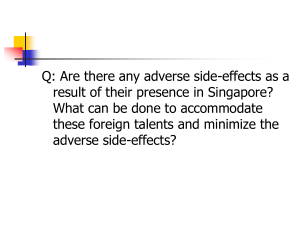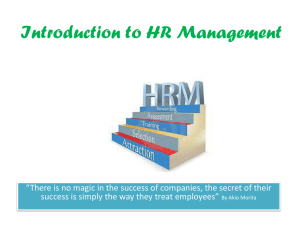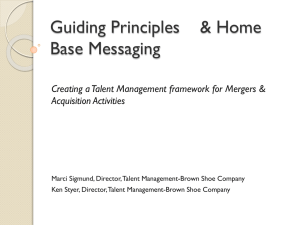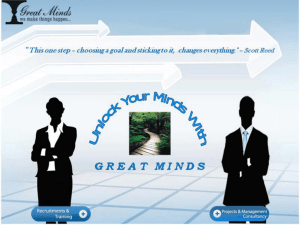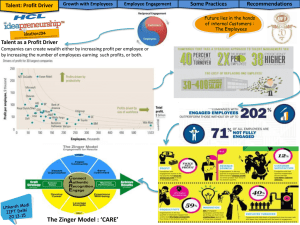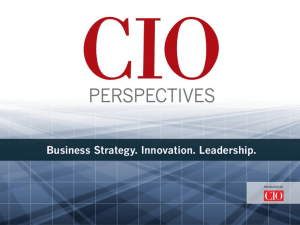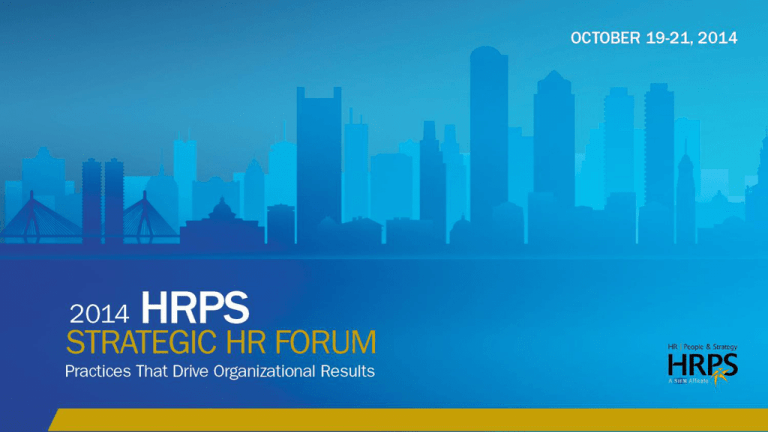
The Convergence of HR and Finance:
Leveraging HR’s Most Powerful Advantage to
Impact the Business
Mark Ubelhart
October 2014
To Achieve Impact—Functions Transition*
• Professional Practice
• Accounting
• Sales
• Human Resources
Decision Science
Finance
Marketing
Human Capital/Talent Management
• When made:
– Possible by information systems
– Essential by scarcity
Drivers of Future Business Value
Source: Mark Van Cleaf,
Organizational Capital Partners
What can we learn from High Performing Companies?
A global study of more than 15,000 performance companies using
30 years of data identified companies which achieved superior CFROI,
Growth and Total Shareholder Returns
“We found that employee engagement and retention was a critical
factor in the ability of companies to achieve superior and sustainable
ROI and Shareholder Value performance.”
Dr. Mark L. Frigo, Director - The Center for Strategy, Execution and Valuation
Kellstadt Graduate School of Business, DePaul University
Co-author of the book DRIVEN: Business Strategy Human Action and the Creation of Wealth
A Strategy Map With Risk Management Embedded
Create and Protect Shareholder
and Stakeholder Value
Financial
Strategic Objectives
Customer
Strategic Objectives
Strategic Themes
Internal Process
Strategic Objectives
Profitable Growth from
New Technologies and
Services
Increase Value from
Existing and New
Customers
Organizational
Efficiency and
Leverage
Cost & Quality
Leadership
Develop Technologies
to Improve Cost &
Performance
Deliver Highly
Valued Solutions
Customer Focused
1- Operational
Excellence
2-Create Value with
Technology
3-Grow High Value
Customer Relationships
4-Organizational
Alignment
Reduce
costs
Disciplined Investment
in New Technologies
Improve Pricing
Discipline
Communication and
Teaming
Improve quality and
costs
continuously
Drive Packaging
Technology
Enable Rapid New
Product introduction
Information Sharing
Leverage
Technology
Leverage an Open
Collaboration
Technology
Transfer Model
Risk Management:
Strategic Risk
Assessment
Improve Productivity
Eliminate non-value
added processes
Licensing
Risk Management:
Liability for Failures
Risk Management:
Protect IP
Risk Management:
Protect Customer
Information
Risk Management:
ERM Initiative
TQ/RRS
TQ/RRS
TQ/RRS
TQ/RRS
Capabilities and
Growth
Strategic Objectives
Roles and Alignment
Organizational Alignment “Create a High Performance Culture and Infrastructure”
Develop Balanced
Scorecard and
Strategy Maps
Retain and Develop
Critical Talent
Develop
Strategic Risk Management
Skills and Culture
Develop Leadership Enable and Encourage
and Execution-Driven Continuous Learning
and Knowledge Sharing
Culture
Source: Frigo, Mark L. and Richard J. Anderson, Strategic Risk Management: A Primer for Directors and Management Teams (2011). Used with permission.
Retention Risk Score
Identifyand
and
Target
At-Risk
Talent
1. Identify
Target
At-Risk
Talent
Creates a common understanding of who is at risk and why…
Employee
Retention Risk Score
Critical Talent
Key Factors Increasing Risk
Jim Smith
726
Yes
Pay history, 6 – 10 yrs tenure
Carol Yu
610
No
New employee, geographic location
Anand Gupta
462
No
Manager tenure, department diversity
Sarah Young
280
Yes
Pay history
Managing Your Talent Risk
Predicting Risk—employee by employee, quarter by
quarter—so that management can:
1. Identify and target at-risk talent
2. Target clusters of risk for group interventions
3. Measure retention performance across units,
across managers
4. Reshape talent sourcing strategies
5. Benchmark your company
Business Framework
to Take Action
Target Clusters of Risk for Group Interventions
Employee
Scores
Segmentation
Methods
Demographic
Segments
• Diversity groups
• Critical talent
• Location
Organizational
Segments
• Business Unit
• Function
• Division
Risk Clusters
Actions
Sales engineers, <2 years experience
in Austin, TX:
High risk but low attrition
Combine
Risk Analysis
with
HR Solutions
Cluster Analysis
• Model-generated
segments
Women managers, age 25-34, in Finance:
Medium risk and high attrition
Manager Training
Compensation
Plan Changes
Alternative
Work
Arrangements
Career
Planning
Workshops
Measure Retention Performance Across Units,
Across Managers
Conventional analysis looks at turnover alone, masking crucial information about “degree of
difficulty”. Talent Guardian offers true performance assessment.
Group 1
Group 2
Predicted
Turnover
40%
Predicted
Turnover
Actual
Turnover
24%
Actual Turnover
+16%
High Retention
Performance
Group 3
22%
Predicted
Turnover
10%
22%
Actual
Turnover
23%
0%
Average Retention
Performance
-13%
Low Retention
Performance
The Message: All three locations had roughly the same turnover. But, Group 1 had the best
performance compared to predicted turnover. And Group 3 the worst.
The Action: Investigate Group 1 for best practices, and Group 3 for root causes.
Talent Guardian™—Actual Client,
Prominent Risk Clusters
“Hired Young Guns”
“Reaching for More”
“Mid-Career Misfires”
3% of population
4% of compensation investment
3% of population
3% of compensation investment
3.5% of population
3% of compensation investment
• Young, though likely not first job
• High performing, relatively high pay
• Tend to live in suburban-like areas
(educated, mid-to-high income,
homeowners, married with
RRS
children)
480
• Average performers
• Recently changed roles/ promoted,
but with relatively small pay increase
• Tend to live in economically
depressed areas
RRS
“Builders”
“Solid Opportunists”
“Struggling Starters”
1% of population
1% of compensation investment
2.5% of population
3% of compensation investment
2.5% of population
2% of compensation investment
•
•
•
•
Young, perhaps first job
Modest pay
Skewed toward Business Unit A
Tend to live in suburban-like
areas
Most Concern
RRS
500
Pivotal/Key Talent Concentration
• Not first job
• Low performers, slow pay
progression
• Tend to live in low income,
relatively uneducated areas
450
•
•
•
•
RRS
490
Average performing
Tend to move between roles
Have relatively high pay
Tend to live in suburban-like areas RRS
• Young, likely first job out of school
• Average to modest performers
• Likely living in relatively low income
areas
RRS
470
460
Secondary Concern
Modest Concern
Retention Risk Complexion Benchmarks
Numbe r of Pe ople
In
Between
21%
Low Ris k
57%
High Ris k
22%
Inv e stme nt in Pe ople
In
Between
29%
High Ris k
24%
Low Ris k
47%
The Link Between…
Retention Risk Scores (RRS)
Talent Quotient and
Business Results
RRS
Pivotal Employees
All Employees
CFROI
All Others
Predicted TQ
Talent Quotient Definition
The people getting the highest total pay increases…
…are they leaving or staying?
The GAAP Equivalent for
Human Capital Reporting
– The relevant information is available
– Standardization within and across companies has
been accomplished
–
Hewitt research demonstrates that a 10% increase
Useinwithin
framework
ofemployees
long-term
shareholder
attractingaand
retaining pivotal
for a company
$10 billionis
in now
capital investment
valuewith
creation
possibleadds an estimated
$70 million to $160 million to its bottom line.
Linkage to Business Results and CFROI
•
Quantifying what has typically been
considered fuzzy—the shareholder
value upside of investing in talent
•
Utilizing "apples-to-apples"
financial results, adjusting for
industry (e.g. financial services)
•
Correcting for “reverse causality"
issues—are pivotal employees
staying (i.e. high TQ) because of
good financial results or does TQ
drive future financial results?
1
Incremental Cost of Talent
versus
Measurable Business Impact
CFROI and Total Business Return
1997 – 2007, N = 115 companies
TQ Uncovers Critical Pipeline Gaps
•
•
Example of Talent Quotient by pay level, highlighting critical future leadership gap for this
company.
Bench strength issue highlighted; TQ not being reported to the Board
TQ RETAIN
160
130
T
Q
120
118
108
100
TQ<100
LOSING
PIVOTAL
EMPLOYEES
70
59
40
BROAD
($50K–
$125K)
MGMT*
($125K–
$200K)
TQ>100
RETAINING
PIVOTAL
EMPLOYEES
EXEC*
($200K+)
TOTAL
($50K+)
Identifying “Stall Points” in Corporate Performance
➤
Nearly 500 executive
interviews
➤
Largest data set
assembled on longterm corporate
performance
➤
Deep analysis of
“stalled companies”
ceburl.com/economist-talent
19
Talent is a Major Factor in Organizational Revenue Stalls
Over 80% of the time, the key controllable factors of revenue stalls in an organization are either
entirely about talent or disproportionately about talent.
Strategic Factors
70%
Premium
Position
Captivity
23%
Regulatory
Actions
7%
Innovation
Management
Breakdown
Premature Core
Abandonment
Failed
Acquisition
10%
7%
13%
Key
Customer
Dependency
6%
Strategic/
Diffusion
Conglomeration
5%
Adjacency
Failures
4%
External Factors
Organizational Factors
13%
17%
Economic
Downturn
4%
© 2014 CEB. All rights reserved.
CEB142868PRINT
National
Labor Market
Inflexibility
1%
Geopolitical
Context
1%
Talent
Bench
Shortfall
9%
Board
Inaction
4%
Organization
Design
2%
Voluntary
Growth
Slowdown
2%
Incorrect
Performance
Metrics
2%
8
Company Specific Results—Big Box Retail
Organization
For each 10 point improvement in TQ…
1.5 – 2.0% improvement in sales per square foot
Can we trust this data?
Relative Sales/ Sq Ft
Growth in Sales/Sq Ft
Controllable Margin
Econometric Methods
to Normalize Store
Performance for
External Factors
Regression Model: Store Performance vs. TQ
Future Sales Sq Ft or Controllable Margin = Function of
Human Capital Metrics, e.g. TQ
(adjusted for reverse causality)
Momentum Building For Human Capital
Accountability Reporting
Many organizations are pursuing such disclosure
• Society for Human Resources Management (SHRM) and its Metrics &
Measures Task Force—suspended
• Sustainable Accounting Standards Board (SASB)
• American National Standards (ANSI) and U.S. Technical Advisory Group
(TAG)
Momentum Building For Human Capital
Accountability Reporting
Many organizations are pursuing such disclosure
• International Standards Organization (ISO) with 42 Nations
participating or observing the development of HR standards
• In the UK, Chartered Institute of Personnel Development (cipd) with
the results becoming law in two years
• CalPERS to engage companies and their external managers on
Governance, Risk Management, Human Capital and Environmental
practices
Human resources measures…
…management and investment information
When will standardized Human Capital metrics become a visible
practice for leading companies? -- 2007 Human Capital Institute Poll:
Accountability Reporting
50%
45%
40%
28%
30%
22%
20%
10%
3%
2%
0%
This Year
Next 2–3 Years
Five Years
Beyond 5 Years
Never
IIRC Guidelines
SASB Approach to Human Capital
•
•
•
•
•
Michael Bloomberg and Mary Shapiro are serving as the Chair and Vice Chair of
SASB
– People of this caliber have the power to change the world
Focus on ESG issues that are material per the SEC
Industry specific approach to human capital metrics
– SASB covers 80+ industries across 10 sectors
Human capital manifests in different ways
– As “Employee Recruitment, Development, and Retention” topics
– As “Fair Labor, Labor Rights, and Human Rights” topics
– As “Employee/Workforce Health & Safety” topics
– As “Employee Inclusion & Diversity” topics
Standards for 5 Sectors available for download at www.sasb.org
Defining Workforce Productivity
• What is our workforce productivity? What is the marginal
return of $1.00 invested in the workforce?
• What is the ROI of our investment in workforce?
• Is our productivity improving? How do we rank?
• Compared to the competition, are we leading or lagging?
© Human Capital
Management Institute
27
Wherefore Human Capital Standardization
• 8/2014 hrfuture.net, by Wilson Wong, the Chair, the Human Capital
Standards Committee at the British Standards Institute; Head of Insights
and Futures at the Chartered Institute of Personnel and Development
(CIPD)
• An aim is to provide a human capital management framework for any
organization where the bulk of the value creation is located in its human
capital
• To enable traditional professional silos of HR, Finance… and so forth to
work instead to best (sustainable) advantage, lower systematic risk to
business continuity and raise professional accountability
Smarter Annual Report
• Descriptive and Prescriptive
• “A Smarter Annual Report—How Companies are Integrating
Financial and Human Capital Reporting” by Laurie Bassi, David
Creelman, Andrew Lambert
• The IIRC has already had a sizable number of large international
companies following its guidelines for integrated reporting on a trial
basis for several years
• The Association of Chartered Certified Accountants survey of 200
CFOs indicates that half of the firms surveyed anticipate adopting
integrated reporting within three years
BSI’s Human Capital Standards
• A diagnostic framework for organizations that are ready to
develop more mature and transparent systems of governance
• 100-day public consultations between Oct 1, 2014 and
Jan 11, 2015
The Center for Talent Reporting
• Home of Talent Development Reporting principles (TDRp)
• Featuring: Securing upfront agreement on expected impact and goal
alignment
• Over 600 measures and 60 sample reports available
A BTS Perspective
• Integrated financial, strategic and human resource planning and decision
making
– model the business—from current state to future state
– capture financial dashboards, employee and customer metrics and
their major interdependencies
– simulate decision making and weighing the risks and returns through
intensive internal training
Source: Dan Parisi, BTS

